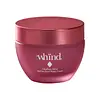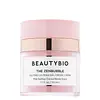What's inside
What's inside
 Key Ingredients
Key Ingredients

 Benefits
Benefits

 Concerns
Concerns

 Ingredients Side-by-side
Ingredients Side-by-side

Water
Skin ConditioningDimethicone
EmollientGlycerin
HumectantButylene Glycol
HumectantSaccharide Isomerate
HumectantDimethicone/PEG-10/15 Crosspolymer
Sodium Chloride
MaskingHydroxyacetophenone
AntioxidantPEG-10 Dimethicone
Skin ConditioningPanthenol
Skin ConditioningDimethicone/Vinyl Dimethicone Crosspolymer
Skin ConditioningCaprylic/Capric Triglyceride
MaskingParfum
MaskingSodium Citrate
BufferingCitric Acid
BufferingSodium Hyaluronate
HumectantPropanediol
SolventDipropylene Glycol
HumectantSalicornia Herbacea Extract
Skin ConditioningOpuntia Ficus-Indica Stem Extract
Skin ConditioningDisodium Phosphate
BufferingXanthan Gum
EmulsifyingSodium Phosphate
BufferingTocopherol
AntioxidantSodium Benzoate
MaskingGlyceryl Caprylate
EmollientPentylene Glycol
Skin ConditioningOpuntia Ficus-Indica Callus Culture Extract
AntioxidantAloe Barbadensis Leaf Extract
EmollientCI 17200
Cosmetic ColorantCitronellol
PerfumingGeraniol
PerfumingWater, Dimethicone, Glycerin, Butylene Glycol, Saccharide Isomerate, Dimethicone/PEG-10/15 Crosspolymer, Sodium Chloride, Hydroxyacetophenone, PEG-10 Dimethicone, Panthenol, Dimethicone/Vinyl Dimethicone Crosspolymer, Caprylic/Capric Triglyceride, Parfum, Sodium Citrate, Citric Acid, Sodium Hyaluronate, Propanediol, Dipropylene Glycol, Salicornia Herbacea Extract, Opuntia Ficus-Indica Stem Extract, Disodium Phosphate, Xanthan Gum, Sodium Phosphate, Tocopherol, Sodium Benzoate, Glyceryl Caprylate, Pentylene Glycol, Opuntia Ficus-Indica Callus Culture Extract, Aloe Barbadensis Leaf Extract, CI 17200, Citronellol, Geraniol
Water
Skin ConditioningGlycerin
HumectantDimethicone
EmollientButylene Glycol
HumectantDiphenylsiloxy Phenyl Trimethicone
Skin ConditioningMicrocrystalline Cellulose
AbsorbentPEG-9 Polydimethylsiloxyethyl Dimethicone
EmulsifyingPolymethylsilsesquioxane
Chamomilla Recutita Flower Extract
MaskingChlorella Vulgaris Extract
Skin ConditioningCentella Asiatica Extract
CleansingTocopherol
AntioxidantSaccharide Isomerate
HumectantCaprylyl Glycol
EmollientDimethicone/Phenyl Vinyl Dimethicone Crosspolymer
Dimethicone/PEG-10/15 Crosspolymer
Dipropylene Glycol
HumectantDisodium EDTA
Cellulose Gum
Emulsion StabilisingLactic Acid
BufferingPropanediol
SolventChlorphenesin
AntimicrobialPhenoxyethanol
PreservativeSodium Citrate
BufferingSodium Chloride
MaskingWater, Glycerin, Dimethicone, Butylene Glycol, Diphenylsiloxy Phenyl Trimethicone, Microcrystalline Cellulose, PEG-9 Polydimethylsiloxyethyl Dimethicone, Polymethylsilsesquioxane, Chamomilla Recutita Flower Extract, Chlorella Vulgaris Extract, Centella Asiatica Extract, Tocopherol, Saccharide Isomerate, Caprylyl Glycol, Dimethicone/Phenyl Vinyl Dimethicone Crosspolymer, Dimethicone/PEG-10/15 Crosspolymer, Dipropylene Glycol, Disodium EDTA, Cellulose Gum, Lactic Acid, Propanediol, Chlorphenesin, Phenoxyethanol, Sodium Citrate, Sodium Chloride
 Reviews
Reviews

Ingredients Explained
These ingredients are found in both products.
Ingredients higher up in an ingredient list are typically present in a larger amount.
Butylene Glycol (or BG) is used within cosmetic products for a few different reasons:
Overall, Butylene Glycol is a safe and well-rounded ingredient that works well with other ingredients.
Though this ingredient works well with most skin types, some people with sensitive skin may experience a reaction such as allergic rashes, closed comedones, or itchiness.
Learn more about Butylene GlycolDimethicone is a type of synthetic silicone created from natural materials such as quartz.
What it does:
Dimethicone comes in different viscosities:
Depending on the viscosity, dimethicone has different properties.
Ingredients lists don't always show which type is used, so we recommend reaching out to the brand if you have questions about the viscosity.
This ingredient is unlikely to cause irritation because it does not get absorbed into skin. However, people with silicone allergies should be careful about using this ingredient.
Note: Dimethicone may contribute to pilling. This is because it is not oil or water soluble, so pilling may occur when layered with products. When mixed with heavy oils in a formula, the outcome is also quite greasy.
Learn more about DimethiconeDimethicone/PEG-10/15 Crosspolymer is a type of silicone.
Dipropylene Glycol is a synthetically created humectant, stabilizer, and solvent.
This ingredient helps:
Dipropylene glycol is technically an alcohol, but it belongs to the glycol family (often considered part of the ‘good’ alcohols). This means it is hydrating and gentle on skin unlike drying solvent alcohols like denatured alcohol.
As a masking agent, Dipropylene Glycol can be used to cover the smell of other ingredients. However, it does not have a scent.
Studies show Dipropylene Glycol is considered safe to use in skincare.
Learn more about Dipropylene GlycolGlycerin is already naturally found in your skin. It helps moisturize and protect your skin.
A study from 2016 found glycerin to be more effective as a humectant than AHAs and hyaluronic acid.
As a humectant, it helps the skin stay hydrated by pulling moisture to your skin. The low molecular weight of glycerin allows it to pull moisture into the deeper layers of your skin.
Hydrated skin improves your skin barrier; Your skin barrier helps protect against irritants and bacteria.
Glycerin has also been found to have antimicrobial and antiviral properties. Due to these properties, glycerin is often used in wound and burn treatments.
In cosmetics, glycerin is usually derived from plants such as soybean or palm. However, it can also be sourced from animals, such as tallow or animal fat.
This ingredient is organic, colorless, odorless, and non-toxic.
Glycerin is the name for this ingredient in American English. British English uses Glycerol/Glycerine.
Learn more about GlycerinPropanediol is an all-star ingredient. It softens, hydrates, and smooths the skin.
It’s often used to:
Propanediol is not likely to cause sensitivity and considered safe to use. It is derived from corn or petroleum with a clear color and no scent.
Learn more about PropanediolSaccharide Isomerate comes from sugars found in corn. It is a skin hydrator.
The structure of this ingredient can be altered to be more similar to the carbohydrates found in our skin. This ability to mimic our skin gives it hydrating properties.
Specifically, saccharide Isomerate is a humectant. Humectants draw moisture from the air to our skin.
Research shows Saccharide Isomerate to be an effective moisturizer.
Learn more about Saccharide IsomerateChances are, you eat sodium chloride every day. Sodium Chloride is also known as table salt.
This ingredient has many purposes in skincare: thickener, emulsifier, and exfoliator.
You'll most likely find this ingredient in cleansers where it is used to create a gel-like texture. As an emulsifier, it also prevents ingredients from separating.
There is much debate on whether this ingredient is comedogenic. The short answer - comedogenic ratings don't tell the whole story. Learn more about comegodenic ratings here.
The concensus about this ingredient causing acne seems to be divided. Research is needed to understand if this ingredient does cause acne.
Scrubs may use salt as the primary exfoliating ingredient.
Learn more about Sodium ChlorideSodium Citrate is the sodium salts of citric acid. In skincare, it is used to alter pH levels and acts as a preservative.
Its main functions are to maintain the pH of a product and neutralize metal ions.
The acidity of our skin is maintained by our glands and skin biome; normal pH level of skin is slightly acidic (~4.75-5.5).
Being slightly acidic allows our skin to create an "acid mantle". This acid mantle is a thin barrier that protects our skin from bacteria and contaminants.
Learn more about Sodium CitrateTocopherol (also known as Vitamin E) is a common antioxidant used to help protect the skin from free-radicals and strengthen the skin barrier. It's also fat soluble - this means our skin is great at absorbing it.
Vitamin E also helps keep your natural skin lipids healthy. Your lipid skin barrier naturally consists of lipids, ceramides, and fatty acids. Vitamin E offers extra protection for your skin’s lipid barrier, keeping your skin healthy and nourished.
Another benefit is a bit of UV protection. Vitamin E helps reduce the damage caused by UVB rays. (It should not replace your sunscreen). Combining it with Vitamin C can decrease sunburned cells and hyperpigmentation after UV exposure.
You might have noticed Vitamin E + C often paired together. This is because it is great at stabilizing Vitamin C. Using the two together helps increase the effectiveness of both ingredients.
There are often claims that Vitamin E can reduce/prevent scarring, but these claims haven't been confirmed by scientific research.
Learn more about TocopherolWater. It's the most common cosmetic ingredient of all. You'll usually see it at the top of ingredient lists, meaning that it makes up the largest part of the product.
So why is it so popular? Water most often acts as a solvent - this means that it helps dissolve other ingredients into the formulation.
You'll also recognize water as that liquid we all need to stay alive. If you see this, drink a glass of water. Stay hydrated!
Learn more about Water